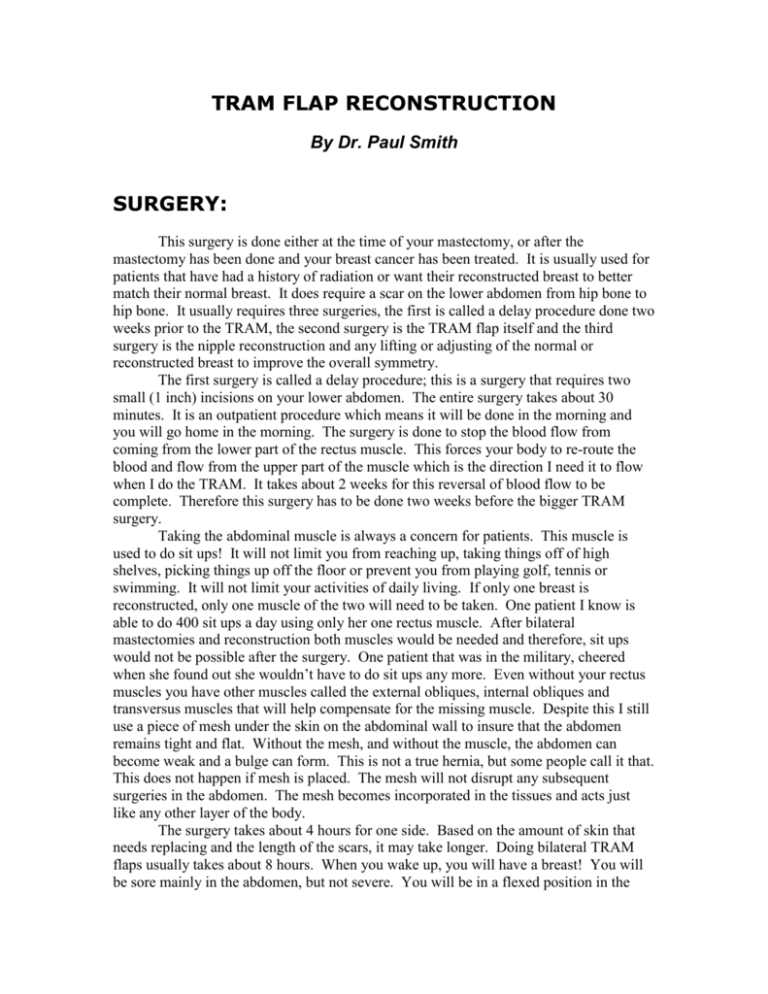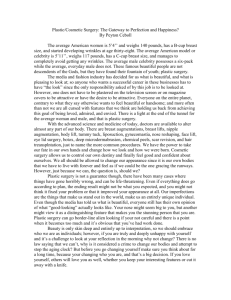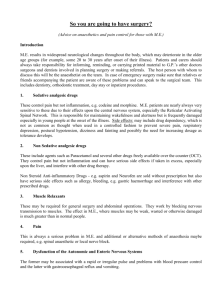EXPANDER ALONE RECONSTRUCTION
advertisement

TRAM FLAP RECONSTRUCTION By Dr. Paul Smith SURGERY: This surgery is done either at the time of your mastectomy, or after the mastectomy has been done and your breast cancer has been treated. It is usually used for patients that have had a history of radiation or want their reconstructed breast to better match their normal breast. It does require a scar on the lower abdomen from hip bone to hip bone. It usually requires three surgeries, the first is called a delay procedure done two weeks prior to the TRAM, the second surgery is the TRAM flap itself and the third surgery is the nipple reconstruction and any lifting or adjusting of the normal or reconstructed breast to improve the overall symmetry. The first surgery is called a delay procedure; this is a surgery that requires two small (1 inch) incisions on your lower abdomen. The entire surgery takes about 30 minutes. It is an outpatient procedure which means it will be done in the morning and you will go home in the morning. The surgery is done to stop the blood flow from coming from the lower part of the rectus muscle. This forces your body to re-route the blood and flow from the upper part of the muscle which is the direction I need it to flow when I do the TRAM. It takes about 2 weeks for this reversal of blood flow to be complete. Therefore this surgery has to be done two weeks before the bigger TRAM surgery. Taking the abdominal muscle is always a concern for patients. This muscle is used to do sit ups! It will not limit you from reaching up, taking things off of high shelves, picking things up off the floor or prevent you from playing golf, tennis or swimming. It will not limit your activities of daily living. If only one breast is reconstructed, only one muscle of the two will need to be taken. One patient I know is able to do 400 sit ups a day using only her one rectus muscle. After bilateral mastectomies and reconstruction both muscles would be needed and therefore, sit ups would not be possible after the surgery. One patient that was in the military, cheered when she found out she wouldn’t have to do sit ups any more. Even without your rectus muscles you have other muscles called the external obliques, internal obliques and transversus muscles that will help compensate for the missing muscle. Despite this I still use a piece of mesh under the skin on the abdominal wall to insure that the abdomen remains tight and flat. Without the mesh, and without the muscle, the abdomen can become weak and a bulge can form. This is not a true hernia, but some people call it that. This does not happen if mesh is placed. The mesh will not disrupt any subsequent surgeries in the abdomen. The mesh becomes incorporated in the tissues and acts just like any other layer of the body. The surgery takes about 4 hours for one side. Based on the amount of skin that needs replacing and the length of the scars, it may take longer. Doing bilateral TRAM flaps usually takes about 8 hours. When you wake up, you will have a breast! You will be sore mainly in the abdomen, but not severe. You will be in a flexed position in the bed, and will need to remain flexed like this for the first 10 days. When you walk on post operative day 1, you will need to walk bent over. This takes tension off of the abdominal incision line. Walking like this over time may cause a low back ache, this is to be expected, remember, you will only need to walk bent over for the first 10 days, after this you can stand up straight. You will have drains placed at the time of surgery that will exit your skin on your lower lateral chest from your breasts and two below you abdominal scar. These are small tubes that come out of your skin and drain any excess blood or fluid. Each drain will be secured into place with a single small black suture. Your incisions will be sutured closed with absorbable sutures, so no stitches will need to be removed later. There will be small strips of cloth adhesive over your suture line called steri-strips. These should remain in place until they fall off by themselves or in about two weeks, whichever comes first. On top of this you will have a white piece of telfa covering the incisions which is secured into place with a thin piece of clear tape called tegaderm. You will then go to the recovery room; Dr. Smith or a member of the plastic surgery team will talk to your family, in about 30 minutes to an hour you will go to the hospital ward, usually on the 5th floor. You will spend two nights in the hospital, possibly three nights. You will be able to have dinner, and should expect to get out of bed to a chair that evening. You will be asked to get up and walk around the nurses station the following day. Your pain will be controlled by pills, usually percocets. If you need more pain medication, you will have a small button that you can push called a PCA that will give you morphine. These medications may cause nausea, so there will be other medications to help prevent this. You will be taught how to take care of your drains, and will be discharged home in two to three days with pain killers, antibiotics and a stool softener. DRESSINGS: The dressings placed over your incisions in the operating room are water-proof. Take these dressings off on the third post operative day if the surgical team has not already done this. If you don’t there is a chance you could get blisters on the skin around the edge of the tegaderm. If you see any blisters, remove the tegaderm immediately. This is not an allergy, it is dependent on your own skin tissue characteristics. If the white telfa under the clear tegaderm does happen to get wet or get soiled with blood, do not leave a wet dressing on your skin! Take the tegaderm and telfa off of your skin, leaving the steri-strips in place. It is OK for the steri-strips to get wet in the shower. Don’t allow the water jet from the shower to directly hit them, just let the water roll over your shoulders gently. Just blot them dry when you are done. Do not soak in a tub or get in a pool or hot tub until the steri-strips are off in about two weeks. DRAIN CARE: When you are at home, expect the drains to be uncomfortable. This is normal. You can “strip” the drain three times a day for the first two days, and then no stripping is required after that. You will need to dump the drainage into a measuring cup twice a day and record how much comes out. The drain cannot be removed until it is putting out less than 30cc’s for 24 hours. You should remove the telfa and tegaderm on post operative day 3. It is also OK for the water to hit directly on the drainage tubes coming out of your skin. It is important to keep this area clean. Use soap and water to clean them and dry them off with a clean towel. Apply a small amount of antibiotic ointment (Bacitracin, Neosporin, Polysporin or any local antibiotic cream you have at home) to the drain site after the shower. You should not resume any exercise activity until the drains are out. Do not go for long walks around the block or go shopping for 3 hours or go to a baseball game where there is a lot of physical activity. Use your common sense! You want to take it easy until the drains are out of your body. The more exercise and activity you are involved in, the longer the drains will be in, because the motion will not allow the skin to adhere down to the underlying muscle and tissue. This does not mean to keep your arms still and remain immobile in bed! Again, use your common sense, you can do normal household activities, dress your hair, prepare dinner, etc. but do not strain yourself. The drains will stay in until they are putting out less than 30cc’s a day. This usually takes between 10 and 14 days. If they are still putting out more than this by three weeks, the drains will still come out. If the drains are removed before this, you will develop a seroma, which is a fluid collection under the skin that can potentially get infected, and will require drainage with a needle through the skin. This usually requires more than one drainage; typically three to four drainages spaced one week apart. Seromas can cause pressure that is uncomfortable. POST OPERATIVE CONCERNS: Expect to take at least six weeks off of work after your TRAM. Some patients require 6 weeks, and others only require 4. It is not possible to determine ahead of time, how the surgery will affect you. So plan on telling your employer six weeks! You will see the plastic surgery team in one week. They will evaluate the incisions and possibly remove the drains. Despite what you have heard, drain removal is NOT a painful procedure. The drains used today are soft and very flexible, you will barely notice! NIPPLE RECONSTUCTION: This is an outpatient procedure. This is done approximately 2 to three months after the TRAM flap. Dr. Smith waits this long to determine what the ultimate shape and location of the breast will be. If the nipples are put on too soon, continued changes in the location of the TRAM will cause the nipples to look displaced or crooked. The nipples are created with the skin of the breast itself. The skin is cut and folded to create a projecting nipple, but this leaves a raw area below the nipple that needs to be covered with a skin graft. This skin graft is usually taken from the lateral abdominal incision where there is excess skin. The skin incision to take the graft is approximately 3 to 4 inches long, but heals well with no significant scarring. There will be no pain at the nipple site, only a small amount of discomfort from the skin graft donor site. Patients only need to take the day after surgery off from work. OTHER PROCEDURES: Other procedures such as breast lifts, breast reductions, liposuction or revisions may be necessary after the TRAM but before the nipple reconstruction to obtain the most symmetric result. Only 3 surgeries are required to get a good result most of the time. OTHER CONCERNS: The entire process takes 4 months. Dr. Smith guarantees that the breasts will look asymmetric when everything is completed. No two breasts are exactly alike and the location of the scars, the way the breast heals and the differences in the amount of fat left on the TRAM flaps all play a role. Dr. Smith also guarantees that he will do his best to make the breasts as symmetrical as he can. Additional procedures such as liposuction and fat grafting may be beneficial, but typically is not covered by insurance, and therefore can be discussed and booked at Dr. Smith’s private cosmetic clinic. The possible complications with this procedure are: 1. Infection 2. Bleeding 3. Scarring 4. Muscle and nerve injury 5. Asymmetry 6. And the need for further surgery







